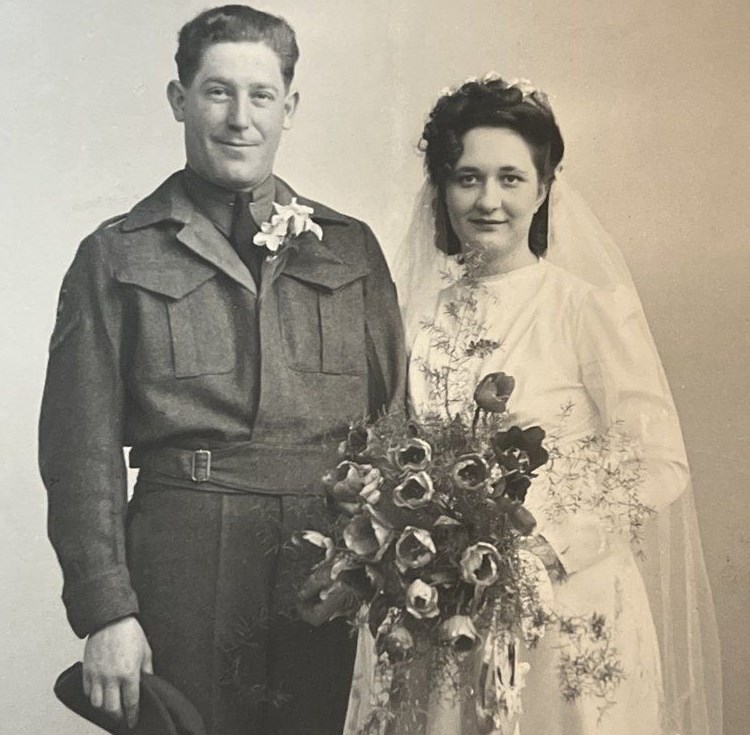SHAUNAVON — Many war brides who docked at Pier 21 in 1946 might have heard strains of the traditional ‘Here Comes the Bride’ played as a welcome tune upon their arrival. While we can’t be certain that Joan Chipperfield heard that when she arrived on The Queen Mary, her story contains elements that were part of the shared experience of war brides throughout Canada.
At the age of 14, Joan Chipperfield was employed as a nanny for a wealthy family in Crawley, Sussex, England. At age 16, shortly after the war began, she worked at a metal manufacturer where they constructed, among other things, lunch kits for soldiers.
Quintin Elmgren, a Canadian soldier, had been deployed to Europe, mostly in Holland. In 1944 or 1945, his regiment was sent back to England, based at Aldershot where Canadian troops were based. When on leave, the Canadians would travel by train to the larger base of Tilgate, south of Crawley, where dances were held.
Joan and her friends would sneak out of their parents’ homes and go to these dances. Quintin and Joan met at one such dance and began corresponding by letter. When Quintin got furlough for a couple of days, he would go back to Tilgate to meet Joan. Joan always emphasized to her children that she had to go through seven (seven!) different fences to get to Tilgate to meet Quintin! All of those obstacles were indeed worth it, as their love story continued.
After the war ended, Quintin was scheduled to ship back to Canada. Joan wanted to join him in Canada but her mother said that Joan could not go unless they were married. After getting special permission from the Canadian Forces, Joan and Quintin were married at a Catholic Church in Crawley on March 30, 1946. Joan was only 17 years old. Twenty-five-year-old Quintin left for Canada in early April. They kept communicating by letter, including letters written during his journey on the ship to Canada. The letters included details about how to get Joan over to Canada, and inquiries about how she’d like to decorate their house in Canada and what colour to paint the bedroom, as Quintin and his brother Bruce were renovating the tiny shack that would become their home. He would also send her chocolate and sugar as they were on rations in Britain and those items were not available to Joan.
Women with children had priority when it came time to ship war brides to Canada. Joan did not yet have children, but her previous experience as a nanny came in handy. She volunteered to look after orphaned children on the ships whose parents had been killed in the war. These children were coming over to adoptive families in Canada. This volunteer arrangement enabled her to move her sailing date up from October to August 6, 1946. Joan boarded the Queen Mary and she arrived in Halifax on August 12.
The majority of war brides settled with their new husbands on the prairie, so a long train ride followed. Joan was accompanied to Saskatchewan by two other war brides, both named Jean, who she maintained friendships with throughout her life. Don and Jean Edwards lived in the Scotsguard area, and the other Jean settled in Estevan. The women attended war bride conferences together a few times in Regina. One other war bride in the area that Joan became close friends with was Cathy Hoisington.
As many war brides have stated in their stories, the hardest thing about the journey was seeing the women whose husbands did not come to meet them in Canada but had abandoned them. This was one of the concerns of British families who bade farewell to their daughters and was probably the reason why Joan’s mother insisted that Quintin marry Joan before sending her to an uncertain future in Canada. Another condition of allowing her to marry was that Quintin had to promise Mrs. Chipperfield to bring Joan back to visit. Joan did return on four different occasions to see her family.
After arriving in Regina on the train, there was another five or six-hour-long journey to their final destination, driving through the vast countryside. Once arriving, Joan had to meet the mother-in-law who was not initially in favour of the nuptials. However, Elizabeth Elmgren quickly got on board with the situation and helped to ensure that Joan had everything she needed. She was a retired schoolteacher and as her grandson, Kent Elmgren, explains, “Grandma’s maiden name was Bos, which was entirely fitting as she kept everyone in line.”
The ‘shack’ that Quintin and Joan lived in eventually got added on to and the house stood until approximately 15 years ago. Their farm was on the correction line between Scotsguard and Simmie in the Early District. Joan did not know anything about farming. Nor had she seen snow before.
Quintin and Joan had six children: Virginia Rae, Sylvia, Michael (Mike), Rose, Kent and Kitty-Ann. Her children don’t recall British traditions being prevalent in their day-to-day life, although they say that their Mom was always a fan of the monarchy and of watching Coronation Street. Kent adds, “Putting ketchup on everything was also attributed to her British upbringing.”
Their youngest, Kitty-Ann, was disabled and Quintin and Joan helped to establish the Houston House for mentally challenged persons in Shaunavon. Joan was a member of the Legion Ladies’ Auxiliary, and Catholic Women’s League, and she enjoyed curling and bowling, two sports that she learned in Canada. The Elmgrens moved to Shaunavon in 1967. Quintin died in 1978 and Joan in 2014.
Kent sums up his Mom’s, and all war bride’s experiences, stating, “Those women were awfully young and awfully brave.”




